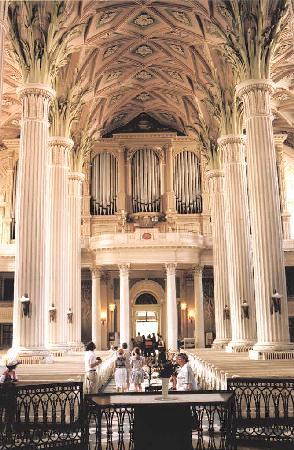J.S. Bach - Lutheran Church in Leipzig
Xinh's project for Mu123, spring/1996
[Bach home page]
Here is a description of the role of music in Lutheran church services in Leipzig and Bach's output of religious music based on Latin texts.

Lutheran Church
Between 1723-29, Bach was employed in Leipzig under the title of Kantor at the St. Thomas Church and civic director of music at Leipzig. His output of religious music consisted mainly of church cantatas. In total, he composed 5 full cycles of cantatas, where one cycle contains 60 cantatas, one for each Sunday of the year in addition to ones composed for special church feasts. Church service would begin at 7AM on Sunday morning and last for 3 hours. The reading of the Gospel was followed by a 30-minute cantata. Bach's musical forces consisted of about 16 singers and 18 instrumentalists. The cantata was then followed by the creed and sermon.
Nikolaikirche in Leipzig, by Jan Koster, 1995
Music Based on Latin Texts
Bach's output of religious music based on Latin texts was not insignificant. Besides the B Minor Mass, he composed the Magnificat, 4 "short" masses, and 5 settings of the Sanctus. Since the churches in Leipzig were Lutheran, one may wonder why the Roman Catholic mass was being set to music. In fact, Luther had retained the Kyrie, Gloria in excelsis, Credo, and Sanctus movements of the Catholic Ordinarium Missae for use in Protestant churches. Thus, in Leipzig, perfomances of the Kyrie, Gloria, Credo, and Sanctus were not uncommon during Bach's lifetime. However, instead of performing the entire Catholic mass, the Missa, which contained only the Kyrie and Gloria, were often used in Protestant churches. In fact, Bach had originally composed the Kyrie and Gloria of the B-Minor Mass as a Missa.
[Back | Bach home page | Next]
Last updated: May 16, 1996
xinh@cco.caltech.edu
